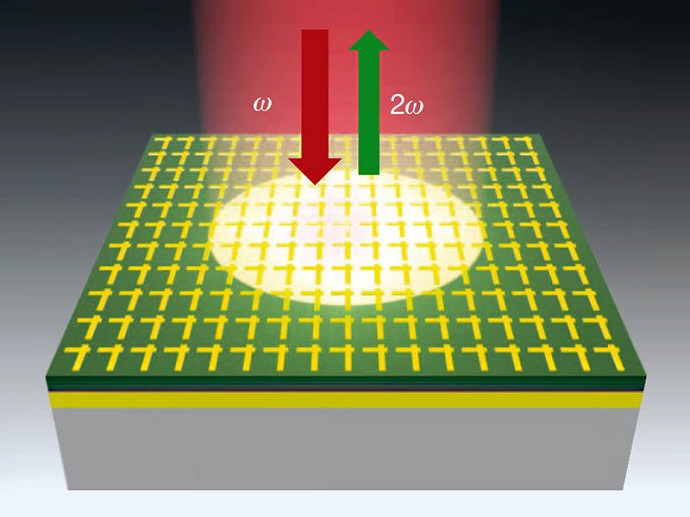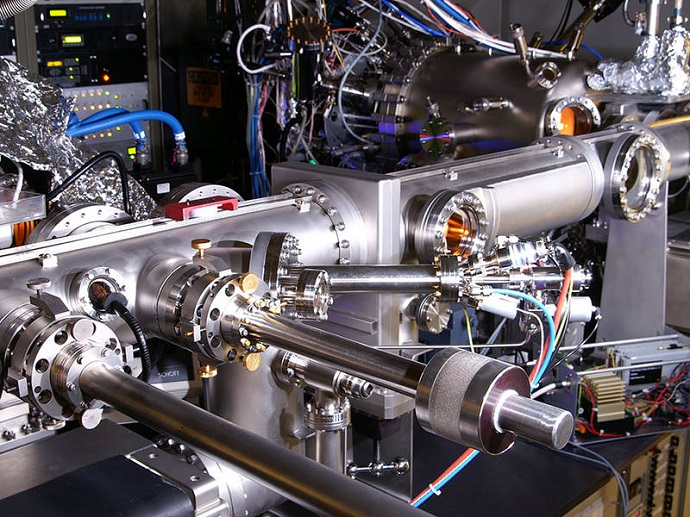July 02, 2014
Nonlinear optical materials are widely used in laser systems. However, high light intensity and long propagation are required to produce strong nonlinear optical effects. Researchers at The University of Texas at Austin and the Technische Universitaet Muenchen created metamaterials with a million times stronger nonlinear optical response, compared to the traditional nonlinear materials, and demonstrated frequency conversion in films 100 times thinner than human hair using light intensity comparable to that of a laser pointer.
Lasers have a fixed place in many fields of application. Yet, there are still wavelengths for which either no systems exist, or at best only large and expensive ones. On the other hand remote sensing and medical applications call for compact laser systems, for example with wavelengths from the near infrared to the Terahertz region.
A team of researchers at the Technische Universitaet Muenchen (Germany) and the University of Texas Austin (USA) has now developed a 400 nanometer thick nonlinear mirror that reflects frequency-doubled output using input light intensity as small as that of a laser pointer. For a given input intensity and structure thickness, the new nonlinear metamaterials produce approximately one million times higher intensity of frequency-doubled output, compared to the best traditional nonlinear materials.
Furthermore, because the frequency conversion happens over subwavelength scales, the demonstrated nonlinear mirrors are free from the stringent requirement of matching the phase velocities of the input and output waves, which complicates nonlinear optical experiments with bulk nonlinear crystals.
The new structures can be tailored to work at various frequencies from near-infrared to mid-infrared to terahertz and can be designed to produce giant nonlinear response for different nonlinear optical processes, such as second harmonic, sum- and difference-frequency generation, as well a variety of four-wave mixing processes.
The super sandwich
The magical material the physicists have created comprises a sequence of thin layers made of indium, gallium and arsenic on the one hand and aluminum, indium and arsenic on the other. They stacked about 100 of these layers, each between one and twelve nanometers thick, on top of each other and sandwiched them between a layer of gold at the bottom and a pattern of asymmetrical, crossed gold nanostructures on top
Tuning the semiconductor layers thicknesses and the gold surface nanostructures geometry, the researchers have two possibilities to adjust the structure to resonate optimally with the desired wavelengths. For the initial demonstration, the material converts light with a wavelength of 8000 nanometers to 4000 nanometers. “Laser light in this frequency range can be used in gas sensors for environmental technology,” says Frederic Demmerle, project member at the Walter Schottky Institute of the TU Muenchen.

400 nanometer thick nonlinear mirror that reflects frequency-doubled output using input light intensity as small as that of a laser pointer – Image: University of Texas (Austin)
Smaller than the wavelength
The ability to double the frequency of a beam of light stems from the engineered electron states in the semiconductor material. When the semiconductor layers are only a few nanometers thick, the electrons can only occupy specific energy states and can be resonantly excited by the electromagnetic radiation.
“This kind of structure is called a coupled quantum well,” says Frederic Demmerle. “Now, when we stack a further thin layer at a precisely defined distance from the first layer, we can push these electron states closer together or pull them apart, adjusting them precisely to the desired wavelength.”
Using the semiconductor material grown at TU Muenchen, a team of researchers at the University of Texas, led by Prof. Mikhail Belkin and Prof. Andrea Alu, designed a pattern of crossed gold structures tailored to have resonances at particular input and output frequencies and fabricated then on top of the semiconductor layer. It is this specific combination of semiconductor material and gold nanostructures engineering that produces giant nonlinear response.
Although the patterns are considerably smaller than the wavelength of the incoming light, the metallic structures ensure that the light is optimally coupled to the material. Their special design also causes a strong increase in field strength at specific locations, which further amplifies the nonlinear response.
Towards the terahertz region
In the future, the team envisions using new materials realized along these lines for other nonlinear effects. “Alongside frequency doubling, our structures may be designed for sum- or difference-frequency generation,” says graduate student Jongwon Lee, at the University of Texas, the lead author on the paper. “These kinds of elements could be used to produce and detect terahertz radiation – which is of interest for sensing and imaging applications, e.g., in medicine, because it does not harm biological tissue.”
“This work opens a new paradigm in nonlinear optics by exploiting the unique combination of exotic wave interaction in metamaterials and of quantum engineering in semicondcutors.” says Professor Andrea Alu.
“On the applications side, our work unveils a pathway towards the development of ultrathin nonlinear optical elements for efficient frequency conversion that will operate without stringent phase-matching constrains of currently-used bulk nonlinear crystals,” says Professor Mikhail Belkin.
The research was funded by the National Science Foundation of USA, the US Air Force Office of Scientific Research, and the US Office of Naval Research, as well as the German Research Foundation in the context of the Excellnce Initiative (Cluster of Excellence Nanosystems Initiative Munich, NIM).
Publication
Giant nonlinear response from plasmonic metasurfaces coupled to intersubband transitions
Jongwon Lee, Mykhailo Tymchenko, Christos Argyropoulos, Pai-Yen Chen, Feng Lu, Frederic Demmerle, Gerhard Boehm, Markus-Christian Amann, Andrea Alù, and Mikhail A. Belkin
Nature, 04.07.2014, DOI: 10.1038/nature13455














